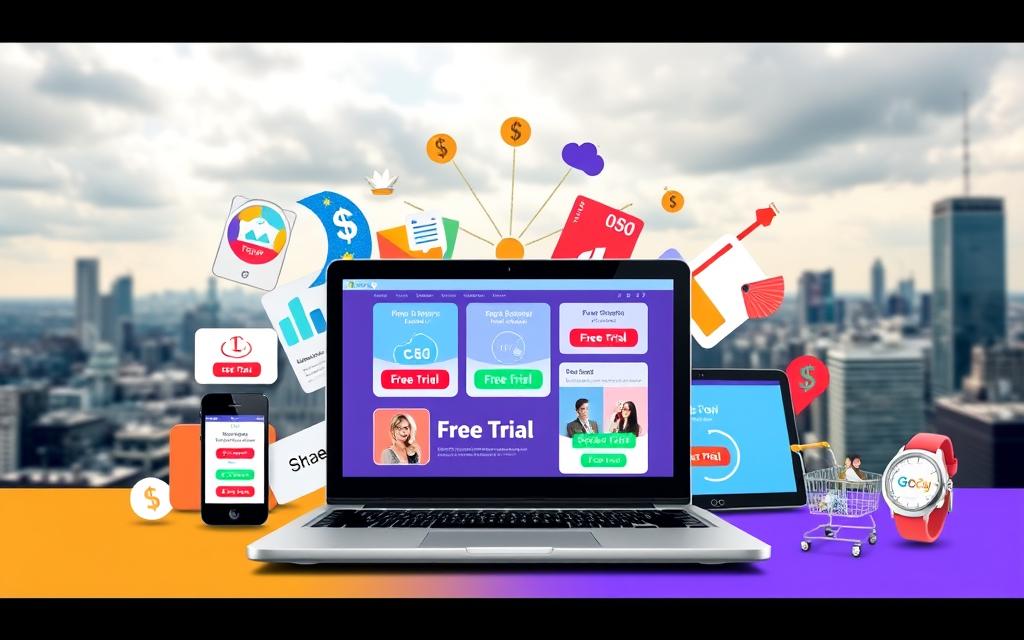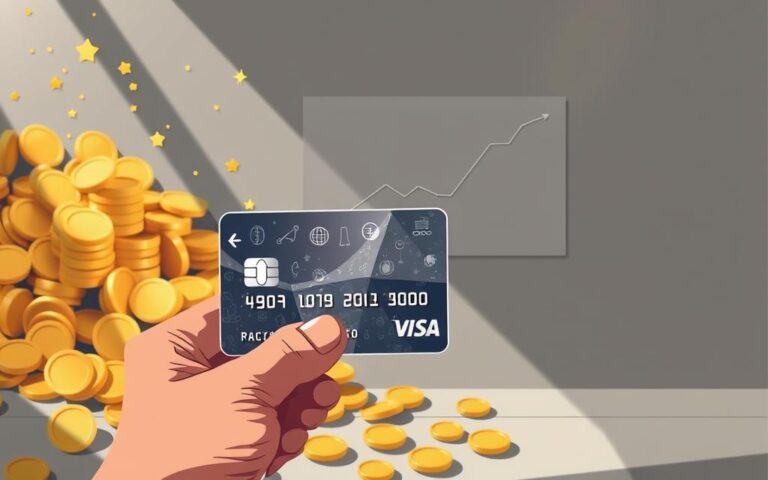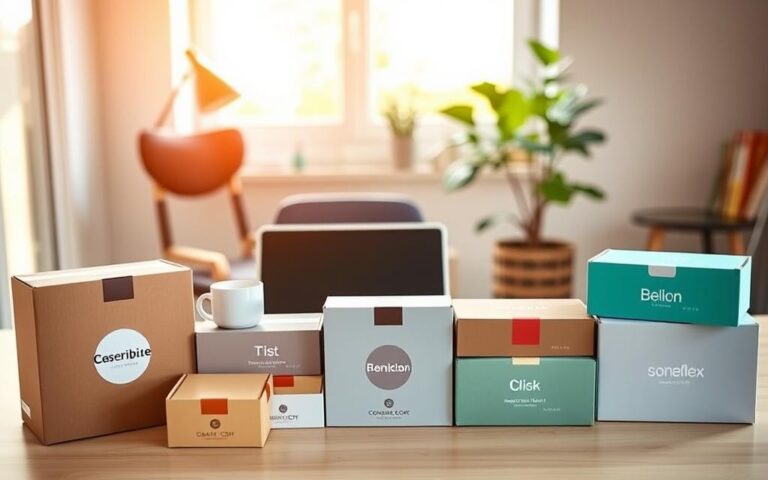Did you know millions of people sign up for free trials every month? They often get charged when the trial ends. This can cause unexpected expenses and financial stress.
Learning how to get free trials without being charged later can save you a lot of money. In this article, we’ll look at different ways to use online tools and services with free trials. By knowing how to handle these offers, you can enjoy their benefits without the surprise of extra charges.
Key Takeaways
- Understand the terms and conditions of free trials before signing up.
- Use online tools to track and manage your trial periods.
- Leverage customer service to cancel or extend your trials.
- Be aware of the cancellation policies of service providers.
- Take advantage of free trial hacks to maximize your savings.
Understanding Free Trials and Their Benefits
Free trials have become a big part of marketing strategies in the digital world. They let people try out products or services before buying them.
Free trials offer a chance to test something without risk. This helps users decide if it’s right for them. It’s good for both businesses and customers, building trust and boosting chances of buying.

What is a Free Trial?
A free trial is a special offer that lets you use something for free for a short time. This time can be a few days to a month. It depends on the company’s trial period optimization plans.
During the trial, you get to try out all the features. This lets you see if it’s a good fit for you.
Why Companies Offer Free Trials
Companies give out free trials to draw in new customers and keep existing ones. It shows what they offer and sets them apart from others.
Free trials also give companies feedback. They learn what customers like and need. This helps them make their products better.
Pros and Cons of Free Trials
Free trials have many benefits, like getting more people involved and making them feel safer. But, they also have downsides, like the chance of misuse and the need for good trial management.
| Pros | Cons |
|---|---|
| Increased customer engagement | Potential for abuse |
| Reduced risk for buyers | Need for effective trial management |
| Valuable feedback for companies | Potential loss if not converted |
Knowing the good and bad points helps businesses make the most of free trials. They can use them to their advantage while avoiding problems.
Common Pitfalls of Free Trials
Many people use free trials, but they often don’t know the common problems. Free trials can be a good way to try software, but there are issues to watch out for.
Automatic Renewals and Charges
One big problem is when trials automatically renew, leading to unexpected charges. Many companies charge your credit card when the trial ends. If you’re not ready, you might pay for something you don’t want.
To avoid this, it’s important to remember when the trial ends. Setting reminders or marking your calendar can help you cancel before being charged.
| Company | Trial Period | Automatic Renewal Policy |
|---|---|---|
| Software A | 30 days | Yes, charges $9.99/month |
| Software B | 14 days | Yes, charges $19.99/month |
| Software C | 60 days | No automatic renewal |
Lack of Clarity in Terms and Conditions
Another issue is unclear terms and conditions in free trials. Some companies hide important details in long terms of service documents. This makes it hard to find important information.
To stay safe, it’s crucial to read the terms and conditions carefully before starting a free trial. Look for how to cancel and what charges will be after the trial.
Essential Hacks for Maximizing Free Trials
To get the most out of free trials, using some smart hacks is key. These hacks help you use the trial period wisely and make smart choices about your subscriptions.
Using Multiple Email Addresses
One smart way to use free trials is by having multiple email addresses. This lets you try out the same service multiple times. For example, you can make extra emails with Google Gmail or Outlook. It’s great for services that only allow one trial per person.
Setting Up Calendar Reminders
Another important hack is setting reminders on your calendar. This way, you won’t forget when your trial ends and avoid extra charges. Use digital calendars like Google Calendar or Apple Calendar to remind you a few days before it’s over. This gives you time to decide if you want to keep the service.
By using these hacks, you can get the most out of your free trials. You’ll save money and find the best services for you.
Researching Before Signing Up
To get the most from free trials, doing your homework is key. This step can save you time and help you find the right fit for you.
Checking Reviews and User Feedback
Before you sign up for a free trial, it’s important to read reviews and user feedback. This lets you know what to expect. Look at reviews on different sites to get a full picture. Notice both the good and bad comments to see the service’s strong and weak points.
For example, you can look at review sites, forums, and social media. This way, you can learn about the service’s usability, features, and quality.
Comparing Similar Services
It’s also smart to compare similar services. Make a list of services you’re interested in and compare their features, prices, and reviews. This helps you choose the best trial for you.
| Service | Features | Pricing | User Reviews |
|---|---|---|---|
| Service A | Feature 1, Feature 2 | $10/month | 4.5/5 |
| Service B | Feature 1, Feature 3 | $15/month | 4.2/5 |
| Service C | Feature 2, Feature 3 | $12/month | 4.8/5 |
By researching, you can get the most out of your free trials and avoid problems. Also, look for trial extension techniques to extend your evaluation time.
Utilizing Virtual Credit Cards
Virtual credit cards are a safe way to sign up for free trials without worrying about unexpected charges. They let you enjoy free trials while keeping your financial info safe.
Setting Up a Virtual Credit Card
To get a virtual credit card, log in to your credit card account online or through a mobile app. Most big banks and credit card companies offer this. Look for the virtual card option in your account settings or payment section.
Steps to Create a Virtual Credit Card:
- Log in to your online banking or credit card account.
- Navigate to the section for managing credit cards or payment methods.
- Select the option to create a new virtual credit card.
- Customize the card details as needed, such as setting a specific credit limit or expiration date.
- Confirm the creation of the virtual credit card.
Benefits of Using Virtual Cards for Trials
Virtual credit cards for free trials offer many benefits, like better security and control over your money. Here are the main advantages:
| Benefit | Description |
|---|---|
| Enhanced Security | Virtual credit cards keep your real card info safe from hackers and unauthorized charges. |
| Control Over Spending | You can set limits on your virtual card to avoid surprise charges. |
| Ease of Cancellation | Virtual cards are easy to cancel or expire, making trial management simpler. |
Using virtual credit cards for trials makes your experience safer and more controlled. It’s great for managing many trials at once. You can easily keep track of different cards and their expiration dates.
The Power of Promotions and Discounts
Promotions and discounts can make your free trial more valuable. By using these offers wisely, you can get more from your trial. You might get a longer trial, extra benefits, or even discounts for later plans.
Finding Promo Codes Online
Looking for promo codes online is a great way to boost your free trial. Websites like RetailMeNot, Coupons.com, or a company’s social media often have codes. These can give you extended trial periods, additional features, or other perks.
When you find promo codes, check if they’re valid and fit your service. Some codes might only work for certain plans or services. Always read the terms and conditions carefully.
Timing Your Sign-Ups for Free Trials
Timing is key when signing up for free trials. Companies often have special deals during holidays or events. By signing up during these times, you can get more from your trial.
For example, some services offer extended trial periods during holidays or Black Friday. Knowing about these deals and planning your sign-up can help you get the most from your trial.
To keep up with promotions, follow your favorite services on social media or sign up for their newsletters. This way, you’ll be the first to know about new deals. It gives you an edge in getting better trial offers.
Keeping Track of Free Trials
Keeping track of free trials is simpler than you might think. With the right tools and strategies, it’s easy to stay on top. It’s important to record the status of each service to avoid unexpected charges.
Organizing Trials with Spreadsheets
Using a spreadsheet is a great way to track free trials. You can list the service name, when you signed up, how long the trial lasts, and when it ends. This helps you manage multiple trials and plan your next steps.
To start your spreadsheet, list these columns:
- Service Name
- Sign-up Date
- Trial Duration
- Expiration Date
- Actions Taken
Here’s what your spreadsheet might look like:
| Service Name | Sign-up Date | Trial Duration | Expiration Date | Actions Taken |
|---|---|---|---|---|
| Streaming Service A | 2023-04-01 | 30 days | 2023-05-01 | Reminder set |
| Software Trial B | 2023-04-05 | 14 days | 2023-04-19 | Canceled |
Utilizing Apps for Trial Management
Another option is to use apps for managing free trials. These apps track your trials and remind you when they’re ending.
Key benefits of using trial management apps include:
- Automated tracking of multiple trials
- Customizable reminders for trial expirations
- Centralized management of your free trials
Using a spreadsheet or a trial management app helps you manage free trials well. This way, you can enjoy their benefits without worrying about extra charges.
Canceling Before the Trial Period Ends
Knowing how to cancel a free trial is crucial to avoid unexpected charges. When you sign up for a free trial, it’s easy to forget about the deadline. But, if you don’t cancel on time, you might face unexpected costs.
Knowing How to Easily Cancel
To cancel a free trial, first, you need to know where to look. Most services let you cancel through their website or app. Look for the account settings or subscription details section. There, you should find the option to cancel.
For example, Dropbox allows users to cancel their subscription directly from their account settings.
“Canceling is straightforward if you know where to look,” says a customer service representative from a leading software trials provider. “We guide our users through the cancellation process to ensure they can easily stop their trial if needed.”
Cancellation Confirmation Importance
After canceling, getting a confirmation is key. This confirmation proves you’ve canceled your subscription. It helps solve any disputes about charges. Keep this confirmation safe, either by saving the email or taking a screenshot.
Effective trial period optimization means knowing how to exit trials well. By understanding the cancellation process and getting a confirmation, you can avoid unwanted charges. This way, you make the most of the free trial experience.
As
“The key to maximizing the benefits of free trials lies in being proactive about canceling before the trial period ends.”
This proactive approach lets you try out services without committing to paid subscriptions unnecessarily.
Leveraging Customer Service for Help
Customer service is often overlooked but it’s crucial for free trials. By reaching out, you can understand trial terms better and maybe get better deals.
Asking About Trial Terms
Asking customer service about trial terms can prevent unexpected charges. Be clear and ask specific questions like when the trial ends, how to cancel, and post-trial charges. This helps you plan and avoid surprises.
For example, you can ask, “What happens if I don’t cancel before the trial ends?” or “Can I get a refund if I cancel during the trial period?” Being proactive and informed can prevent future problems.
Getting Extensions if Needed
If you need more time, ask customer service for a trial extension. Some companies offer this as a courtesy to valued customers. Be polite and explain your reason, and you might get an extension.
When asking for an extension, have a valid reason ready. This could be needing more time to evaluate or being on vacation. Being honest and courteous can help get a positive response.
Using customer service well can make your free trial better. You might get trial conversion tips or an extension using trial extension techniques. Customer service is a key resource for a better experience.
Following Up with Feedback
Sharing your thoughts after a trial period can make your experience better. It helps the service improve and might lead to better offers later on.
Providing Feedback to Companies
When you give feedback after a free trial, you share important insights. This can lead to improvements and optimizations for everyone. Companies usually take feedback seriously to make their services better.
To give good feedback, be clear and to the point. Say what you liked and what could be better. Many companies have special places for feedback, making it easy to share your thoughts.
Requesting Discounts for Future Plans
If you want to keep using a service, asking for a discount is smart. Companies like to keep loyal customers and might offer discounts. When you ask, talk about your positive trial experience and ask for a discount.
Also, ask about any promotions or loyalty programs they have. This way, you might save money and keep enjoying the service.
Making the Most of Free Trials
To get the most out of free trials, know what you need before you start. Figure out what you want from a product or service. Then, use the trial to see if it fits your needs, like online tools for marketing.
Assessing Your Needs
Before you begin a free trial, think about what you need. Look at the features your business must have. See if the product or service can provide them.
Being clear about your needs helps you use free trials better. You’ll make smarter choices and improve your marketing.



